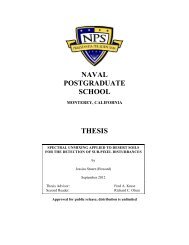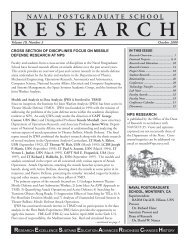High Energy Laser Testbed for Accurate Beam Pointing Control
High Energy Laser Testbed for Accurate Beam Pointing Control
High Energy Laser Testbed for Accurate Beam Pointing Control
Create successful ePaper yourself
Turn your PDF publications into a flip-book with our unique Google optimized e-Paper software.
where n x and y n are jointly stationary random processes, and E {} is the expected value operator. In reality, a<br />
correlation estimate given by Equation 2 have to be used since only a finite segment of one realization of the infinite<br />
length random process was available.<br />
N−m−1 ⎧ *<br />
⎪ xn+ m⋅yn n=<br />
0<br />
⎫<br />
m≥0⎪<br />
⎪ ˆ *<br />
Ryx ( − m) m<<br />
0⎪<br />
ˆ ∑<br />
Rxy ( m)<br />
= ⎨ ⎬<br />
(2)<br />
⎩ ⎭<br />
Additionally, coherence function calculation was also required. Coherence shows the portion of the output spectrum<br />
related to the input spectrum as given by Equations (12)-(14)<br />
where G xy is the cross spectrum and<br />
power spectrum.<br />
G ⋅G<br />
γ =<br />
G ⋅G<br />
*<br />
2 xy xy<br />
xx yy<br />
G = FFT ( Rˆ<br />
)<br />
(4)<br />
xy xy<br />
G = FFT ( Rˆ<br />
)<br />
(5)<br />
xx xx<br />
*<br />
G xy is its complex conjugate, xx<br />
(3)<br />
G is the input power spectrum and the output<br />
Coherence is an indication of statistical validity of frequency response measurements and is measured on a scale of 0.0-<br />
1.0, with a value of 1.0 corresponding to perfect coherence. Reasons <strong>for</strong> a coherence value less than one include poor<br />
resolution, nonlinearities, extraneous noise and uncorrelated input signals. Additionally, it is independent of the shape of<br />
the frequency response function since it has been normalized. Finally, the frequency response, also called the “Transfer<br />
function” is calculated based on a ratio of the cross spectrum to input power spectrum as given by<br />
Gxy<br />
H( f)<br />
= (6)<br />
G<br />
The resulting transfer functions are shown in Figures 7 and 8. The 3dB bandwidth is 6Hz <strong>for</strong> the azimuth axis, and 7Hz<br />
<strong>for</strong> elevation. Additionally, resonance frequencies in the azimuth axis of 8.2Hz, 11.4Hz, and 15.9Hz caused significant<br />
reduction in tracking per<strong>for</strong>mance.<br />
Figure 7. Azimuth Axis Transfer Function<br />
Proc. of SPIE Vol. 7587 75870G-6<br />
Downloaded from SPIE Digital Library on 31 Jul 2012 to 205.155.65.56. Terms of Use: http://spiedl.org/terms<br />
xx
















